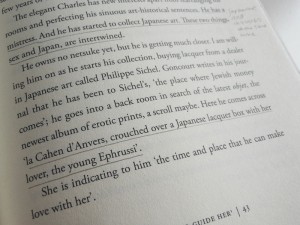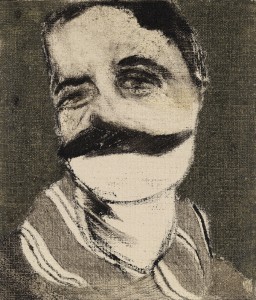R.B. Kitaj is known for his expressive, strongly-colored paintings and the retrospective at the Jewish Museum does these qualities full justice. Though for me personally, one of the most appealing works was at first unprepossessing. It is very small, barely 15 x 13 cm, in shades of grey – more a study than a painting. The Portrait of Aby Warburg (1958) depicts the pioneer of methodical iconography, who lived from 1866 to 1929. The son of a Hamburg banker, who passed on a career in the family business in order to become an artist and art historian, Warburg was an important inspiration for the painter Kitaj. Warburg studied the afterlife of ancient motifs in Renaissance art, an interest Kitaj shared insofar as he systematically quoted artworks from past eras in his own paintings. → continue reading
Dandy and Cowboy
Cycling Holiday
Maybe I should have fasted, but instead, I was rubbing my injured knee and wrist, picking up my bicycle from the road where I’d fallen.
 On Yom Kippur, the Day of Atonement, one is supposed to reflect on one’s sins over the last year, to apologize to friends and family, to pray and to fast. And as it is the holiest of all Jewish holidays, it is widely respected in Israel, even by atheists. Trains, buses, and airplanes all stop running; shops and restaurants remain closed; even driving a car is taboo. And so, with the streets and highways empty and nothing on the radio or TV, it has become the perfect occasion for those of us who don’t take atonement all that seriously to go out for a bike ride. → continue reading
On Yom Kippur, the Day of Atonement, one is supposed to reflect on one’s sins over the last year, to apologize to friends and family, to pray and to fast. And as it is the holiest of all Jewish holidays, it is widely respected in Israel, even by atheists. Trains, buses, and airplanes all stop running; shops and restaurants remain closed; even driving a car is taboo. And so, with the streets and highways empty and nothing on the radio or TV, it has become the perfect occasion for those of us who don’t take atonement all that seriously to go out for a bike ride. → continue reading
An Exhibition in Book Form
An unexpected success in England and still climbing bestseller rungs all over the world, The Hare with the Amber Eyes by Edmund de Waal is an exhibition in book form. The author, a potter, tells the history of his Jewish banking family, the Ephrussis, via the artifacts it collected, cared for, and bequeathed. 
The objects gain meaning via detailed descriptions. Who acquired them, at which time, for what purpose? What do they say about their buyer’s character, heritage, and destiny? Among the artifacts is the title-giving “Hare with Amber Eyes,” one of 264 Japanese netsuke wood and ivory carvings, which changes hands many times. → continue reading
